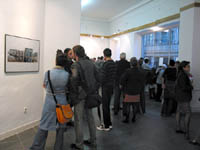| transformative urbanism from Almere to Caracas |
|||
| Exhibition Galeria Noua, Bucarest Romania October 8th - November 2nd, 2003 |
<< |
||
|
|
|||
| press information: Since 1993, Bitter and Weber have addressed urbanism and architecture as social and spatial relations through photography, video, and new media technologies. "Transformative urbanism: From Almere to Caracas" draws from Bitter and Weber's work on urban landscapes in Europe and Latin America and includes the series "On Formation", "almere.text" and "Caracas, Hecho en Venezuela" (Caracas, made in Venezuela). "Transformative urbanism: From Almere to Caracas" engages with the economic, social, political and cultural forces central to a shift from an urbanism of transformations to a transformative urbanism. Bitter and Weber's investigation of the city does not limit the urban territory and built space to a formal and material question, but looks at long-term social, cultural and economic processes that reshape everyday life in the city. |
|||
 Caracas, hecho en Venezuela, 2003 Overview 23 De Enero, 6 photographs, each 15 x 22 cm  Caracas, hecho en Venezuela, 2003 23 De Enero, 3 combinations of 2 photographs, each 30 x 45 cm  Caracas, hecho en Venezuela 2003 Façade 23 De Enero, photograph 30 x 90 cm  Caracas, hecho en Venezuela, 2003 Aerial view 23 De Enero with embedded text of the new Constitution of the Bolivarian Republic of Venzuela, 4 prints, each 100 x 230 cm |
While participating in the urban research project CaracasCase for six months in 2003 -- a project initiated by Caracas Urban Thinktank and funded by the Federal Cultural Foundation of Germany -- the artists encountered urban processes in the Venzuelan capital that are central to a greater social transformation and not merely the appropriation of space within existing social relations. These collective everyday practices produce the new spatial and socialrelations of Caracas, and, in a larger sense, they produce Caracas. Following Henri Lefebvre's concept of the 'production of space' in "Caracas, Hecho en Venezuela", Bitter and Weber emphasize two prodcutive processes of the city: the super blocks of the area '23 De Enero'built by Carlos Raul Villanueva in the 1950s and the self-built shanty town that grew in and around the super blocks; and the new 1999 constitution of the Bolivarian Republic of Venezuela. To link these two, Bitter and Weber alter an aerial image of 23 de Enero area with software they developed. Through this process the aerial image is reconstructed with text characters and the entire Constitution of the Bolivarian Republic of Venezuela. The aerial photograph mimics the scopic regime of a modernism which sought to rationalize spatial relations; yet the Venezuelan Constitution aims at an opposing view which tries to build a participatory democracy from the streets up. 23 de Enero represents the transformation from modernist rationality to an insurgent urbanism - an insurgency made through the politics of its inhabitants. Bitter & Weber chose 23 de Enero as an example of contested modernist urban planning and architecture and as a site of political struggle - for example, through the mass squatting of 1958. This aerial work is complemented in the exhibition by a series of colour-photographs that take a different view of 23 de Enero by detailing the architecture as it has been reshaped by decades of use. |
||
 Almere.txt, 2000 Wallpaper, dimensions variable Text: Jeff Derksen |
The wallpaper "almere.txt" addresses the shift in housing politics from state subsidised social housing to individual housing, based on private property and individual interest. The countless single-family houses of the new leisure city in the Netherlands are the core elements of a text-like pattern. The houses are duplicated and stacked into formations resembling large social housing projects -- which Almere is a reaction to -- and highrise buildings, which are now proposed as a visual skyline in order to identify the huge flat one-family housing area as a "city". |
||
 On Formation, 1995 Digital print laminated, 130 x 480 cm |
In the work "On Formation" from 1995 the artists address "urbanism" without architecture. Based on a found image from the 50s they digitally generated group formations of people through the multiplication of the single people. The large-scale panoramatic image of circles, squares, grids and lines made from single figures metaphorically point toward the forces and conflicts which construct a city. |
||
 Z_orb, 2000 Videoloop 3’40 sec Sound: Peter Rantasa |
The black and white video projection, "Z_orb", shows a clear inflatable orb, with a person ensnared within, spinning in a black, depthless space. Originally designed as a leisure sport device, the orb was video-taped rolling down hills in the Austrian alps. By rendered the sylvan alps as a flat black field, the zorb places the zorb in its architectural references: The slightly sci-fi inflatable structures of the sixties and seventies and the utopian potential of inflatable structures which held the promise of new architectural and social meanings through a flexible relationship of the body to built space. What happens to the utopian potential in architecture when the leisure class is rolled down the hill? |
||
galeria noua / new gallery curator: Aurora Dediu Str. Academiei 15, Bucaresti 1 ROMANIA October 8th - November 2nd, 2003 wed-sun 11.00-19.00 |
 photos: Josif Kiraly |
||
|
exhibition support: WIEN KULTUR
thanks a lot to all the students of Josif Kiralys seminar for helping to install the exhibition the project "CARACAS, HECHO EN VENEZUELA" is part of the caracascase, a project of the Federal Cultural Foundation of Germany and the Caracas Urban Think Tank |
|||
